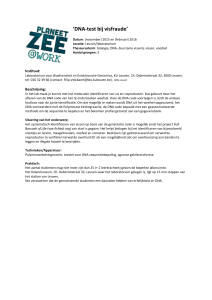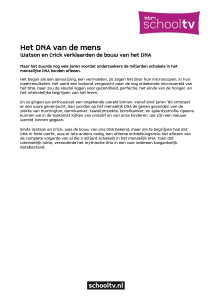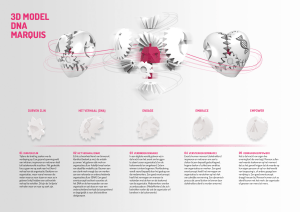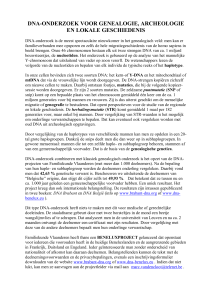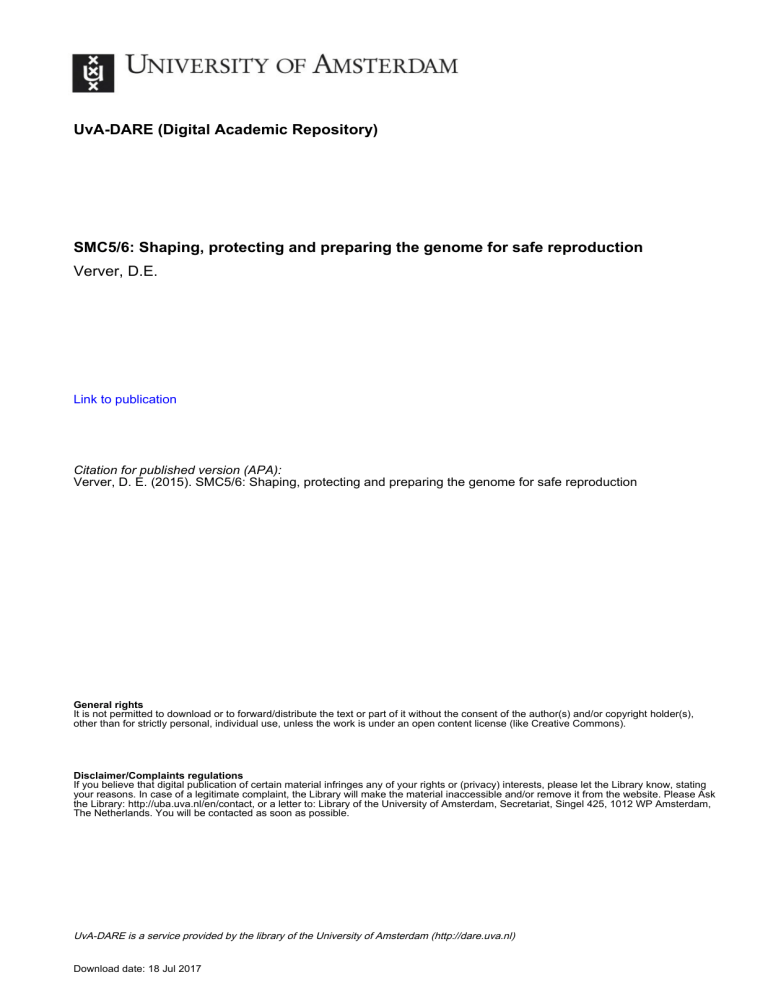
UvA-DARE (Digital Academic Repository)
SMC5/6: Shaping, protecting and preparing the genome for safe reproduction
Verver, D.E.
Link to publication
Citation for published version (APA):
Verver, D. E. (2015). SMC5/6: Shaping, protecting and preparing the genome for safe reproduction
General rights
It is not permitted to download or to forward/distribute the text or part of it without the consent of the author(s) and/or copyright holder(s),
other than for strictly personal, individual use, unless the work is under an open content license (like Creative Commons).
Disclaimer/Complaints regulations
If you believe that digital publication of certain material infringes any of your rights or (privacy) interests, please let the Library know, stating
your reasons. In case of a legitimate complaint, the Library will make the material inaccessible and/or remove it from the website. Please Ask
the Library: http://uba.uva.nl/en/contact, or a letter to: Library of the University of Amsterdam, Secretariat, Singel 425, 1012 WP Amsterdam,
The Netherlands. You will be contacted as soon as possible.
UvA-DARE is a service provided by the library of the University of Amsterdam (http://dare.uva.nl)
Download date: 18 Jul 2017
Chapter
7
Summary
Samenvatting
List of Abbreviations
110
Chapter 7
Summary
The aim of this thesis was to gain understanding in the mechanisms that shape, protect
and prepare the genome for reproduction, one of the most complex and challenging, yet
essential, processes of species survival. We especially focused on one of the three Structural
Maintenance of Chromosomes (SMC) protein complexes called SMC5/6, known to be involved
in the dynamic structure of chromatin during genome replication and DNA damage repair.
Even though this protein complex is found to be involved in numerous processes critical for
genome integrity maintenance, its role in germ cell development is poorly understood. We
therefore investigated the possible roles of SMC5/6 in rodent and human spermatogenesis,
and concluded that this complex is likely to be involved in many important spermatogenic
processes, such as spermatogonial differentiation, meiotic recombination and homologous
chromosome synapsis and segregation.
In chapter 1 we introduce the stages of spermatogenesis, with special emphasis on meiosis
and meiotic recombination. It furthermore provides an overview of the SMC protein families
and the known (somatic) functions of the SMC5/6 complex.
In chapter 2, we have investigated the role of SMC6 during rodent spermatogenesis. We
showed that rodent SMC6 expression coincides with the transition of undifferentiated to differentiating spermatogonia. Throughout mouse spermatogenesis we found SMC6 to localize
to pericentromeric heterochromatin regions, chromatin domains that contain densely packed,
repetitive DNA sequences surrounding the centromeres. Because we found these domains to
lack DNA repair or recombination sites (marked by γH2AX or Rad51 respectively), we hypothesize that SMC5/6 plays a role in the prevention of aberrant recombination events between
pericentromeric regions during the first meiotic prophase that would otherwise cause chromosomal aberrations leading to apoptosis, meiotic arrest or aneuploidies.
In chapter 3, we aimed to translate the recent findings considering the SMC5/6 complex
in mouse spermatogenesis to the human situation. Indeed, also the human testis contained
subpopulations of SMC6 negative and positive spermatogonia, which were equally distributed amongst type Adark and type Apale spermatogonia, potentially reflecting the differentiation
status of spermatogonia. In contrast to the mouse, human SMC6 was not located at pericentromeric heterochromatin, suggesting species dependent differences in the maintenance of
genomic integrity at the repetitive pericentromeric regions. In addition, we found SMC5 and
SMC6 to locate at synapsed homologous chromosomes during the first meiotic prophase and
at centromeres during meiotic metaphases. Finally, unsynapsed chromosomes (including
the sex chromosomes) exhibited side by side SMC6 and RAD51 foci, indicating that SMC5/6
could be involved in DNA double strand break repair on these chromosomes. Taken together,
our data clearly indicate that the SMC5/6 complex is involved in a variety of crucial processes
during human spermatogenesis, including spermatogonial development, synaptonemal complex assembly or stability and meiotic centromere cohesion.
Chapter 4 provides an overview of the many meiotic functions of SMC5/6 described using
models from yeast to man, thereby underlying both the complexity of the process of meiosis
and the versatility of the SMC5/6 complex. Nevertheless, when comparing the diverse meiotic
Summary
111
(and mitotic) functions of SMC5/6, at least one clear common denominator was found: the capacity to resolve recombination intermediates that occur after repair of DSBs by homologous
recombination.
In chapter 5, we first briefly studied the mechanism by which SMC6 might be regulated in
germ cells. By mass spectrometry, we revealed a potential posttranslationally modified form
of SMC6 to be the protein SEC23IP that non-specifically interacts with one of our SMC6 antibodies. Additionally, and confirmed by immunoprecipitation, a strong physical interaction
between the SMC5/6 complex and the DNA topoisomerase TOP2A was found. In order to study
the role of the SMC5/6 complex in DNA repair and homologous recombination, we successfully targeted the SMC5/6 subunit NSE2 by CRISPR-Cas9 in a human cell line (U2OS). All NSE2
null cells showed a delay in cell cycle progression and 10% of the cells arrested at G0/1. Surprisingly, no clear difference in cell survival capacity was observed between WT and NSE2 null
cells when exposed to DNA damaging agents ionizing radiation and cisplatin. However, NSE2
null cells did show an increased sensitivity to the topoisomerase inhibitor etoposide. This, together with the observed interaction between SMC5/6 and TOP2A, suggests that the SMC5/6
complex is specifically involved in resolving replication induced topological stress, likely by
mediating repair of TOP2A induced DSBs.
In chapter 6 we discuss the relevance of the obtained results and the implications for
further research in genome integrity maintenance and male reproduction.
112
Chapter 7
Samenvatting
Het doel van dit proefschrift was om kennis te vergaren over de mechanismen die zorg
dragen voor het vormgeven, beschermen en voorbereiden van het genoom tijdens de voortplanting; één van de meest complexe, uitdagende en tegelijkertijd essentiële processen van
overleving. In het bijzonder hebben wij ons gericht op één van de drie SMC eiwitcomplexen
genaamd SMC5/6, welke voornamelijk verantwoordelijk is gebleken voor de dynamische
structuur van chromatine die gepaard gaat met het herstel van DNA schade. Hoewel gevonden is dat dit eiwitcomplex betrokken is bij verschillende processen die essentieel zijn voor het
behouden van een intact genoom, is de rol van SMC5/6 in ontwikkelende voortplantingscellen nog onduidelijk. Wij hebben daarom de potentiële rol van SMC5/6 tijdens de spermatogenese onderzocht, en concluderen dat dit complex naar alle waarschijnlijkheid betrokken
is bij meerdere belangrijke processen, waaronder spermatogoniale differentiatie, paring van
homologe chromosomen tijdens de meiose, meiotische recombinatie en, uiteindelijk, chromosoomsegregatie tijdens de twee meiotische celdelingen.
In hoofdstuk 1 introduceren we de verschillende stadia van spermatogenese, met extra
aandacht voor meiose en meiotische recombinatie. Daarnaast geeft het een overzicht van de
verschillende SMC eiwitcomplexen en de reeds bekende functies van het SMC5/6 complex.
In hoofdstuk 2 bestuderen we de rol van SMC6 tijdens spermatogenese in knaagdieren.
We laten zien dat expressie van SMC6 gelijk op gaat met het differentiëren van spermatogonia.
Gedurende de spermatogenese lokaliseert SMC6 op het pericentromerisch heterochromatine,
chromatine domeinen rond de centromeren die dicht opeen gepakte, repetitieve stukken
DNA bevatten. Omdat deze domeinen tevens géén DNA schade herstel of recombinatie laten
zien (in de vorm van γH2AX en Rad51 foci), veronderstellen wij dat SMC5/6 een rol speelt in
het voorkomen van foutieve recombinatie tussen pericentromerische regio’s tijdens de eerste
meiotische profase. Meiotische recombinatie tussen deze domeinen zou anders tot chromosomale afwijkingen en vervolgens celdood, meiotisch arrest of aneuploïdie kunnen leiden.
Het doel van hoofdstuk 3 is om de recente bevindingen van studies over de rol van
SMC5/6 tijdens de spermatogenese van de muis te vertalen naar humane spermatogenese.
Ook in de humane testis vinden we twee spermatogoniale subpopulaties: SMC6-negatieve
en –positieve spermatogonia die mogelijk een afspiegeling zijn van de differentiatie status van
humane spermatogoniën. In tegenstelling tot de muis, lokaliseert humaan SMC6 niet met pericentromerisch heterochromatine. Dit duidt er op dat in de mens SMC5/6 niet betrokken is bij
de instandhouding van de integriteit van repetitieve pericentromerische DNA sequenties. Wel
vinden we zowel SMC5 als SMC6 op de gepaarde homologe chromosomen tijdens de eerste
meiotische profase, en op de centromeren tijdens de meiotische metaphases. Tenslotte laten
ongepaarde chromosomen (inclusief de geslachtschromosomen) SMC6 en RAD51 foci zien,
wat suggereert dat SMC5/6 betrokken is bij het herstellen van DNA-schade op deze chromosomen. Samenvattend laat onze data zien dat het SMC5/6 complex betrokken is bij een breed
scala aan cruciale processen tijdens de humane spermatogenese, waaronder spermatogoniale
differentiatie, synaptonemal complex opbouw of stabiliteit (paring van de homologe chromosomen) en centromeer cohesie tijden meiotische delingen.
Samenvatting
113
Hoofdstuk 4 geeft een overzicht van de vele meiotische functies van SMC5/6 beschreven
in studies van gist tot mens die zowel de complexiteit van meiose als de diversiteit van het
SMC5/6 complex illustreren. Tijdens het vergelijken van de diverse meiotische (en mitotische)
functies van SMC5/6, kan desondanks een gemene deler gevonden worden in het vermogen
om complexe DNA structuren, die ontstaan tijdens DNA schade herstel middels homologe
recombinatie, op te lossen.
In hoofdstuk 5 beschrijven we eerst kort de mechanismen waarbij SMC6 mogelijk gereguleerd wordt in voortplantingscellen. Met massa spectroscopie laten we vervolgens zien dat
een mogelijke post-translationeel gemodificeerde vorm van SMC6 in feite een aspecifieke interactie van een van onze antilichamen met het eiwit SEC23IP blijkt te zijn. Daarnaast tonen we,
met massa spectroscopie en immunoprecipitatie, een sterke fysieke interactie aan tussen het
SMC5/6 complex en de DNA topoisomerase TOP2A. Om de rol van SMC5/6 in DNA schade herstel en homologe recombinatie te bestuderen, hebben we de SMC5/6 subunit NSE2 verwijdert
uit een humane cellijn (U2OS) met CRISPR-Cas9. Alle NSE2 null-cellen laten een vertraging in
cel cyclus zien en 10% van deze cellen stagneert in G0/1. Wanneer we DNA schade aanbrengen
door middel van ioniserende straling of cisplatin, zien we echter geen groot verschil in overleving tussen de wildtype en NSE2 null-cellen. De NSE2 null-cellen blijken wel een verhoogde
gevoeligheid te hebben voor de topoisomerase remmer etoposide. Samen met de gevonden
interactie tussen SMC5/6 en TOP2A, suggereert dit dat het SMC5/6 complex specifiek betrokken is bij het herstellen van DNA schade die gemaakt wordt door TOP2A gedurende replicatie.
In hoofdstuk 6 bespreken we de relevantie van de verkregen resultaten en de implicaties
voor het onderzoek naar genoom integriteit en mannelijke voortplanting in de toekomst.
114
Chapter 7
List of Abbreviations
ALT
Cas9
CO
CRISPR
DAPI
dHJ
dsDNA
DNA
DSB
DSBR
HJ
HR
HU
IH
IP
IR
IS
JM
MSCI
MSUC
NCO
NER
NHEJ
NLS
NSE
rDNA
RNA
SAC
SC
SCI
SDSA
SEI
SMC
SSC
ssDNA
SUMO
TopoII
TOP2
VAD
WT
Alternative lengthening of telomeres
CRISPR-associated protein 9
Crossover
Clustered regulatory interspaced short palindromic repeats
4’6-diamidino-2-phenylindole•2HCl
Double Holliday junction
Double-stranded DNA
Deoxyribonucleic acid
DNA double-strand break
DNA double-strand break repair
Holliday junction
Homologous recombination
Hydroxyurea
Inter-homolog
Immunoprecipitation
Ionizing radiation
Inter-sister
Aberrant joint molecule
Meiotic sex chromosome inactivation
Meiotic silencing of unsynapsed chromosomes
Non-crossover
Nucleotide excision repair
Non-homologous end joining
Nuclear localization sequence
Non-SMC element
Ribosomal DNA
Ribonucleic acid
spindle assembly checkpoint
Synaptonemal complex
Sister chromatid intertwining
Synthesis-dependent single-strand annealing
Single-end invasion
Structural maintenance of chromosomes
Spermatogonial stem cell
Single-stranded DNA
Small ubiquitin-related modifier
Topoisomerase 2
Topoisomerase 2
Vitamin A-deficient
Wildtype

